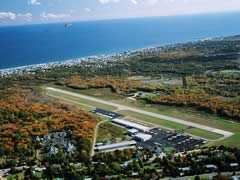NTSB: Pilot Should Have Picked Different Airport
 The NTSB says there are two reasons
a Cessna 414 with a Riley Super-8 conversion crashed at Marshfield
Municipal Airport (WI) two years ago: engine problems and pilot
error.
The NTSB says there are two reasons
a Cessna 414 with a Riley Super-8 conversion crashed at Marshfield
Municipal Airport (WI) two years ago: engine problems and pilot
error.
The Marshfield News Herald reports CFIs Mitchell
Schier, 41, and Andrew Maly, 31, both of Marshfield, along with
Michael Cervi, 30, of Marana (AZ), died in the crash. Shier was
trying to land the aircraft after it started losing power in the
left engine. The three were headed to Doniphan (MO) in the 1974
Cessna.
The NTSB Report
The airplane was destroyed after an attempted landing following
a reported partial power loss of the left engine while en route.
The flight did not divert to the closest airport located about 27
nautical miles to the southwest while at an altitude of about
15,900 feet. This airport was a controlled field equipped with
airport rescue and fire fighting (ARFF), and its longest runway was
9,005 feet. The flight diverted to the departure airport located
about 93 nautical miles to the north. This airport was an
uncontrolled field not equipped with ARFF, and its longest runway
was 5,000 feet. No emergency was declared.
The airplane was reported by a witness to be too high and too
fast to land on runway 34 at the airport. The winds were from 140
degrees at 6 knots. The wreckage distribution was consistent with
an impact resulting from a Vmc (minimum control speed with the
critical engine inoperative) roll to the left.
The pilot received a checkout from the right seat in the
accident airplane by the airplane owner. The checkout was about 20
minutes in duration and did not include any single-engine flight
maneuvers or emergency procedures. The owner did not hold a
certified flight instructor certificate. The pilot had stopped
flying for 12 years and just began giving flight instruction and
flying in single-engine airplanes about a year prior to the
accident. The pilot's recent multiengine flight experience was
limited to a couple of non-revenue flights within the past year
while seated in the right seat of a King Air. The King Air was used
for commercial charter work which would involve one or two landings
per flight. One landing was made on the day prior to the accident.
The accident pilot asked the King Air pilot to accompany him along
on the accident flight; the King Air pilot declined. A multiengine
commercial rated pilot-rated passenger, who the accident pilot
knew, was seated in the right front seat.
 Examination of the airplane's
supplemental type certificate (STC) revealed that the airplane had
undergone numerous inspections by different maintenance personnel.
The left engine's variable absolute pressure controller had safety
wire around its control arm, which precluded its normal operation
and a pressure relief valve that was not called for in the STC
drawings. At the time of issuance, Federal Regulation's did not
require STC instructions for continued airworthiness. Reliance on
the airplane and engine maintenance manuals would not have provided
enough information for continued airworthiness in accordance with
the STC and could have yielded a setting exceeding those for which
the STC parts were originally certificated to and thus increasing
Vmc speed.
Examination of the airplane's
supplemental type certificate (STC) revealed that the airplane had
undergone numerous inspections by different maintenance personnel.
The left engine's variable absolute pressure controller had safety
wire around its control arm, which precluded its normal operation
and a pressure relief valve that was not called for in the STC
drawings. At the time of issuance, Federal Regulation's did not
require STC instructions for continued airworthiness. Reliance on
the airplane and engine maintenance manuals would not have provided
enough information for continued airworthiness in accordance with
the STC and could have yielded a setting exceeding those for which
the STC parts were originally certificated to and thus increasing
Vmc speed.
Examination of the left engine revealed a cylinder head
separation on the number six cylinder assembly, which had
accumulated an estimated time since installation of 240 hours.
Visual inspection of the assembly revealed the presence of some
undecipherable characters in its parts numbering. A cylinder head
separation from another airplane was also examined. This cylinder
assembly accumulated about 270 hours since installation. Both
cylinder assembly examinations revealed the presence of additional
material on the cylinder barrel threads and fatigue fracture on the
cylinder head.
The National Transportation Safety Board determines the
probable cause(s) of this accident as follows:
The pilot's failure to maintain adequate airspeed (Vmc) which
resulted in a loss of control. Contributing factors were the
improper in-flight planning/decision not to land at a closer
airport and the lack of recent experience in multiengine airplanes
by the pilot-in-command, the cylinder head separation, the
inadequate manufacturing process, and the lack of continued
airworthiness instructions relating to the Riley Super-8 STC.
 Bolen Gives Congress a Rare Thumbs-Up
Bolen Gives Congress a Rare Thumbs-Up The SportPlane Resource Guide RETURNS!!!!
The SportPlane Resource Guide RETURNS!!!! Buying Sprees Continue: Textron eAviation Takes On Amazilia Aerospace
Buying Sprees Continue: Textron eAviation Takes On Amazilia Aerospace Hawker 4000 Bizjets Gain Nav System, Data Link STC
Hawker 4000 Bizjets Gain Nav System, Data Link STC Echodyne Gets BVLOS Waiver for AiRanger Aircraft
Echodyne Gets BVLOS Waiver for AiRanger Aircraft




